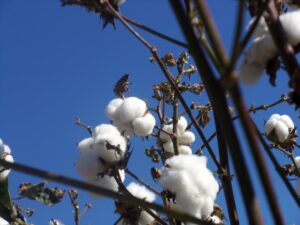COTTON
December cotton is weaker today, seeing pressure from the strong dollar. The US harvest is advancing, but it could be slowed by heavy rainfall expected for Texas and the Delta over the next five days. Traders may have to look to tomorrow’s weekly export sales report or the USDA supply demand report on Friday for direction. Last week’s export sales report showed net sales of 189,436 bales for the week ending October 24. This was the third straight week they were above 150,000 after being below that level for the previous five weeks. Last year, sales picked up dramatically around this time, starting with 457,000 bales on October 26, and followed by 396,000, 331,000 and 334,000 over the ensuing three weeks. US production could be lowered in Friday’s reports, as Georgia’s conditions have not recovered from the hurricanes. Tropical Storm Rafael is expected to grow to a Category 1 hurricane this week, with possible landfall along Louisiana this week. This could bring rain to the Delta, but it is not expected to be anywhere near as strong as Helene.

COFFEE
December Coffee was lower overnight with the strength in the dollar. The nearby Brazilian real fell to its lowest level since March 2020 last Friday, and this increases the incentive for producers and roasters to sell their product for export. The outlook for the upcoming Brazilian has improved crop substantially with the recent rainfall. There are questions as to whether the rains will be enough to produce a strong crop, but each day of rain increases the chances. Vietnam exported 1.15 million metric tons of coffee in the first 10 months of 2024, down 11.2% from the same period last year, according to government data. In October, the country exported 44,000 tons, up 1.5% from last year. Their harvest officially began last month.
COCOA
Cocoa, like many commodities, is under pressure this morning with the rally in the dollar in the wake of the re-election of Donald Trump. The dollar has had its biggest one-day increase since March 2020, and a move like this encourages exporters outside the US to sell commodities, and it makes US-produced commodities less competitive on the world market. Sources at Ivory Coast’s Coffee and Cocoa Council told Reuters that cumulative cocoa arrivals at Ivory Coast ports for the 2024/25 season (starting October 1) are expected to reach 1 million metric tons by the end of January. This is not very impressive considering arrivals had reached 1.008 million tons at the end of January 2024 and 1.540 million the year before that. Arrivals as of November 3 were up 26% year on year at 365,000 tons. These sources cited heavy rains and floods and the threat of brown rot as a reason for arrivals to fall off in December. The director of a European export company said planters are having difficulty delivering good cocoa. He is estimating damaged beans are running around 20-25% of the total. This contrasts with a mostly positive outlook from farmers this season. Reuters also interviewed about 20 Ghanian farmers, Cocobod officials, and local buyers who said they see healthier pods in Ghana than last year due to improved rainfall and sunshine. West Africa saw very little rain over the past 24 hours. Forecasts call for showers and thunderstorms mostly confined to the coast, while should see dry conditions good for crop development and maturation.
SUGAR
March Sugar is close to taking out Monday’s three-week lows. The strong dollar/weak Brazilian real encourages Brazilian sugar producers to sell their product for export. Three days ago the Brazilian real fell to its lowest level in 4 ½ years, which encourages mills to sell for export. A good rainfall pattern continues in Brazil, which improves the outlook for the 2025/26 crop after the extended drought earlier this year (and wildfires) had raised significant concerns. The rains are expected to slow harvest and production in the near term and perhaps bring an early end to the 2024/25 season, which typically concludes in late November or early December.
Interested in more futures markets? Explore our Market Dashboards here.
Futures and options trading involve significant risk of loss and may not be suitable for everyone. Therefore, carefully consider whether such trading is suitable for you in light of your financial condition. The information and comments contained herein is provided by ADMIS and in no way should be construed to be information provided by ADM. The author of this report did not have a financial interest in any of the contracts discussed in this report at the time the report was prepared. The information provided is designed to assist in your analysis and evaluation of the futures and options markets. However, any decisions you may make to buy, sell or hold a futures or options position on such research are entirely your own and not in any way deemed to be endorsed by or attributed to ADMIS. Copyright ADM Investor Services, Inc.
